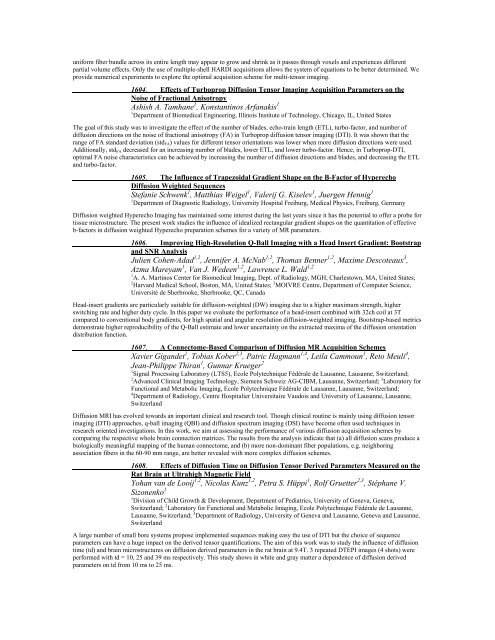Traditional Posters: Diffusion & Perfusion - ismrm
Traditional Posters: Diffusion & Perfusion - ismrm
Traditional Posters: Diffusion & Perfusion - ismrm
Create successful ePaper yourself
Turn your PDF publications into a flip-book with our unique Google optimized e-Paper software.
uniform fiber bundle across its entire length may appear to grow and shrink as it passes through voxels and experiences different<br />
partial volume effects. Only the use of multiple-shell HARDI acquisitions allows the system of equations to be better determined. We<br />
provide numerical experiments to explore the optimal acquisition scheme for multi-tensor imaging.<br />
1604. Effects of Turboprop <strong>Diffusion</strong> Tensor Imaging Acquisition Parameters on the<br />
Noise of Fractional Anisotropy<br />
Ashish A. Tamhane 1 , Konstantinos Arfanakis 1<br />
1 Department of Biomedical Engineering, Illinois Institute of Technology, Chicago, IL, United States<br />
The goal of this study was to investigate the effect of the number of blades, echo-train length (ETL), turbo-factor, and number of<br />
diffusion directions on the noise of fractional anisotropy (FA) in Turboprop diffusion tensor imaging (DTI). It was shown that the<br />
range of FA standard deviation (std FA ) values for different tensor orientations was lower when more diffusion directions were used.<br />
Additionally, std FA decreased for an increasing number of blades, lower ETL, and lower turbo-factor. Hence, in Turboprop-DTI,<br />
optimal FA noise characteristics can be achieved by increasing the number of diffusion directions and blades, and decreasing the ETL<br />
and turbo-factor.<br />
1605. The Influence of Trapezoidal Gradient Shape on the B-Factor of Hyperecho<br />
<strong>Diffusion</strong> Weighted Sequences<br />
Stefanie Schwenk 1 , Matthias Weigel 1 , Valerij G. Kiselev 1 , Juergen Hennig 1<br />
1 Department of Diagnostic Radiology, University Hospital Freiburg, Medical Physics, Freiburg, Germany<br />
<strong>Diffusion</strong> weighted Hyperecho Imaging has maintained some interest during the last years since it has the potential to offer a probe for<br />
tissue microstructure. The present work studies the influence of idealized rectangular gradient shapes on the quantitation of effective<br />
b-factors in diffusion weighted Hyperecho preparation schemes for a variety of MR parameters.<br />
1606. Improving High-Resolution Q-Ball Imaging with a Head Insert Gradient: Bootstrap<br />
and SNR Analysis<br />
Julien Cohen-Adad 1,2 , Jennifer A. McNab 1,2 , Thomas Benner 1,2 , Maxime Descoteaux 3 ,<br />
Azma Mareyam 1 , Van J. Wedeen 1,2 , Lawrence L. Wald 1,2<br />
1 A. A. Martinos Center for Biomedical Imaging, Dept. of Radiology, MGH, Charlestown, MA, United States;<br />
2 Harvard Medical School, Boston, MA, United States; 3 MOIVRE Centre, Department of Computer Science,<br />
Université de Sherbrooke, Sherbrooke, QC, Canada<br />
Head-insert gradients are particularly suitable for diffusion-weighted (DW) imaging due to a higher maximum strength, higher<br />
switching rate and higher duty cycle. In this paper we evaluate the performance of a head-insert combined with 32ch coil at 3T<br />
compared to conventional body gradients, for high spatial and angular resolution diffusion-weighted imaging. Bootstrap-based metrics<br />
demonstrate higher reproducibility of the Q-Ball estimate and lower uncertainty on the extracted maxima of the diffusion orientation<br />
distribution function.<br />
1607. A Connectome-Based Comparison of <strong>Diffusion</strong> MR Acquisition Schemes<br />
Xavier Gigandet 1 , Tobias Kober 2,3 , Patric Hagmann 1,4 , Leila Cammoun 1 , Reto Meuli 4 ,<br />
Jean-Philippe Thiran 1 , Gunnar Krueger 2<br />
1 Signal Processing Laboratory (LTS5), Ecole Polytechnique Fédérale de Lausanne, Lausanne, Switzerland;<br />
2 Advanced Clinical Imaging Technology, Siemens Schweiz AG-CIBM, Lausanne, Switzerland; 3 Laboratory for<br />
Functional and Metabolic Imaging, Ecole Polytechnique Fédérale de Lausanne, Lausanne, Switzerland;<br />
4 Department of Radiology, Centre Hospitalier Universitaire Vaudois and University of Lausanne, Lausanne,<br />
Switzerland<br />
<strong>Diffusion</strong> MRI has evolved towards an important clinical and research tool. Though clinical routine is mainly using diffusion tensor<br />
imaging (DTI) approaches, q-ball imaging (QBI) and diffusion spectrum imaging (DSI) have become often used techniques in<br />
research oriented investigations. In this work, we aim at assessing the performance of various diffusion acquisition schemes by<br />
comparing the respective whole brain connection matrices. The results from the analysis indicate that (a) all diffusion scans produce a<br />
biologically meaningful mapping of the human connectome, and (b) more non-dominant fiber populations, e.g. neighboring<br />
association fibers in the 60-90 mm range, are better revealed with more complex diffusion schemes.<br />
1608. Effects of <strong>Diffusion</strong> Time on <strong>Diffusion</strong> Tensor Derived Parameters Measured on the<br />
Rat Brain at Ultrahigh Magnetic Field<br />
Yohan van de Looij 1,2 , Nicolas Kunz 1,2 , Petra S. Hüppi 1 , Rolf Gruetter 2,3 , Stéphane V.<br />
Sizonenko 1<br />
1 Division of Child Growth & Development, Department of Pediatrics, University of Geneva, Geneva,<br />
Switzerland; 2 Laboratory for Functional and Metabolic Imaging, Ecole Polytechnique Fédérale de Lausanne,<br />
Lausanne, Switzerland; 3 Department of Radiology, University of Geneva and Lausanne, Geneva and Lausanne,<br />
Switzerland<br />
A large number of small bore systems propose implemented sequences making easy the use of DTI but the choice of sequence<br />
parameters can have a huge impact on the derived tensor quantifications. The aim of this work was to study the influence of diffusion<br />
time (td) and brain microstructures on diffusion derived parameters in the rat brain at 9.4T. 3 repeated DTEPI images (4 shots) were<br />
performed with td = 10, 25 and 39 ms respectively. This study shows in white and gray matter a dependence of diffusion derived<br />
parameters on td from 10 ms to 25 ms.















